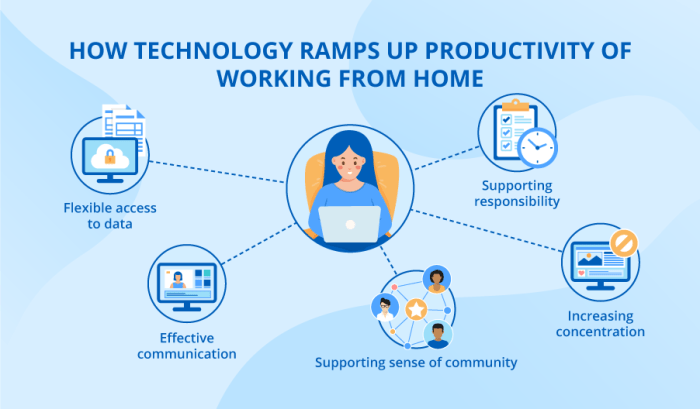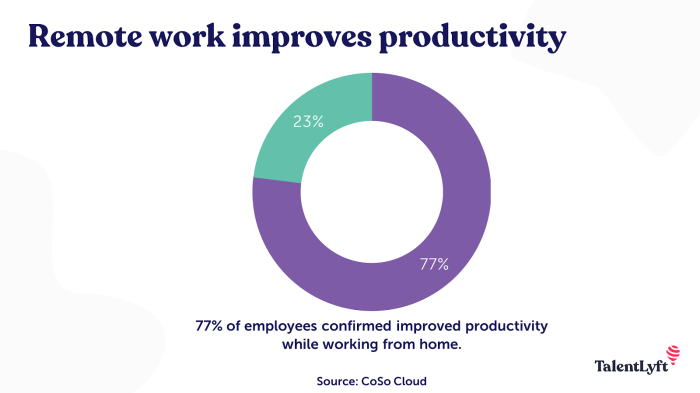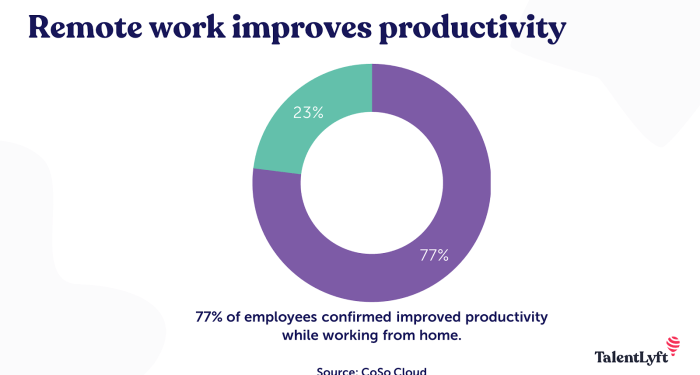Effective remote work productivity software is the cornerstone of successful remote work setups, offering a seamless way to boost productivity and collaboration. As remote work becomes more prevalent, the right software tools can make all the difference in ensuring a smooth and efficient workflow.
Let's delve into the world of remote work productivity software and explore how it can revolutionize the way we work remotely.
In this article, we will explore the key aspects of effective remote work productivity software, from essential features to best practices for implementation, and strategies for overcoming common challenges.
Importance of Effective Remote Work Productivity Software

Having the right software for remote work productivity is crucial in ensuring that remote teams can collaborate efficiently and effectively. With the rise of remote work, the need for tools that can streamline tasks, enhance communication, and boost productivity has become more important than ever.
Streamlining Tasks and Enhancing Collaboration
Effective remote work productivity software can help teams streamline tasks by providing a centralized platform for project management, task assignments, and progress tracking. For example, project management tools like Trello or Asana allow team members to create tasks, assign them to specific individuals, set deadlines, and track progress in real-time.
This not only helps in organizing workflows but also ensures transparency and accountability within the team.Collaboration tools such as Slack or Microsoft Teams facilitate communication and collaboration among team members, regardless of their physical location. These tools offer features like instant messaging, file sharing, video conferencing, and screen sharing, enabling seamless communication and real-time collaboration.
By using such tools, remote teams can overcome communication barriers and work together efficiently towards common goals.
Impact of Ineffective Software on Remote Work Efficiency
On the other hand, using ineffective software for remote work can have a significant negative impact on productivity and efficiency. Outdated or inefficient tools can result in communication delays, data loss, and confusion among team members. For instance, using email as the primary mode of communication for remote teams can lead to overflowing inboxes, missed messages, and difficulty in tracking important information.Moreover, without the right software tools, remote teams may struggle to stay organized, meet deadlines, and collaborate effectively.
This can result in decreased productivity, missed opportunities, and ultimately, a negative impact on the overall success of the team and the organization.In conclusion, having the right remote work productivity software is essential for remote teams to work efficiently, collaborate effectively, and achieve their goals.
By leveraging the right tools, remote teams can overcome the challenges of distance and time zones, and work together seamlessly towards success.
Features to Look for in Remote Work Productivity Software
When choosing remote work productivity software, it is essential to consider key features that can enhance collaboration, efficiency, and security in a remote work environment.
Task Management
Effective task management tools are crucial in remote work software to help teams organize, assign, and track tasks efficiently. Look for features such as task prioritization, deadlines, progress tracking, and notifications to ensure seamless workflow management.
Communication Tools
Communication is vital in remote work settings, so software with robust communication tools like instant messaging, video conferencing, and file sharing capabilities is essential. These tools facilitate real-time collaboration, feedback exchange, and team connectivity.
Integration Capabilities
Choose remote work software that offers integration with other tools and platforms commonly used by your team. Seamless integration with project management tools, cloud storage services, and communication apps can streamline workflows and enhance productivity.
Security Features
Security is a top priority when selecting remote work software. Look for features such as end-to-end encryption, data access controls, and secure login protocols to protect sensitive information and ensure compliance with data privacy regulations.
Customization Abilities
Opt for software that allows customization to adapt to your team's unique workflow and preferences. Customizable dashboards, task templates, and reporting functionalities can help tailor the software to meet specific needs and maximize productivity.
Scalability
Consider the scalability of the remote work software to accommodate your team's growth and evolving needs. Scalable software can easily adjust to changes in team size, workload, and project complexity without compromising performance or user experience.
Best Practices for Implementing Remote Work Productivity Software

Implementing remote work productivity software can significantly improve efficiency and collaboration within a team. Here are some best practices to consider when introducing new software to remote teams.
Step-by-Step Guide to Introduce New Software
- Start by clearly communicating the purpose and benefits of the new software to all team members.
- Provide comprehensive training sessions to ensure employees are comfortable using the software effectively.
- Encourage open communication and feedback from team members throughout the implementation process.
- Set realistic goals and expectations for the software implementation and track progress regularly.
Strategies for Training Employees
- Offer a variety of training methods, such as video tutorials, live demonstrations, and hands-on practice sessions.
- Assign dedicated mentors or trainers to provide ongoing support and guidance to employees as they learn to use the software.
- Create user-friendly guides and documentation to help employees troubleshoot common issues independently.
- Encourage team collaboration and knowledge sharing to enhance learning and adoption of the new software.
Tips for Monitoring and Evaluating Software Impact
- Utilize analytics and reporting features within the software to track usage, productivity metrics, and user feedback.
- Regularly review performance data to identify areas for improvement and address any issues promptly.
- Solicit feedback from employees on their experience with the software and make adjustments based on their input.
- Celebrate successes and milestones achieved through the use of the software to motivate and engage team members.
Overcoming Challenges with Remote Work Productivity Software

Remote work productivity software can bring numerous benefits to a team, but it also comes with its own set of challenges that need to be addressed for optimal efficiency.
User Adoption
One of the common challenges with remote work productivity software is getting team members to fully adopt and utilize the tools provided. This can be due to resistance to change or lack of understanding of the software's capabilities.
- Provide comprehensive training sessions to educate users on how to effectively use the software.
- Highlight the benefits of the software and how it can streamline work processes and improve collaboration.
- Encourage feedback from users to address any issues or concerns they may have.
Technical Difficulties
Another challenge that may arise is technical difficulties with the software, such as bugs, glitches, or compatibility issues with different devices or operating systems.
- Ensure regular software updates are implemented to address any known issues and improve performance.
- Have a dedicated IT support team available to troubleshoot technical problems remotely and provide timely solutions.
- Encourage users to report any technical issues they encounter promptly for swift resolution.
Compatibility with Existing Tools
Integrating remote work productivity software with existing tools and systems within the organization can also pose a challenge, especially if there are compatibility issues or data transfer issues.
- Conduct a thorough compatibility assessment before implementing the software to identify any potential integration challenges.
- Work with the software provider to customize solutions or integrations that meet the organization's specific needs.
- Provide training on how to effectively use the integrated tools to ensure a smooth transition and maximize efficiency.
Role of IT Support
IT support plays a crucial role in maintaining and optimizing remote work software by providing technical assistance, troubleshooting, and ensuring the software functions smoothly for all users.
- Establish a dedicated IT support team that is readily available to address any software-related issues and provide assistance as needed.
- Offer remote support options for users to easily access IT assistance without the need for on-site visits.
- Regularly monitor the performance of the software and address any potential issues proactively to prevent disruptions in workflow.
Final Thoughts

In conclusion, effective remote work productivity software holds the key to unlocking the full potential of remote teams. By investing in the right tools and practices, organizations can create a productive and collaborative remote work environment that drives success. Embrace the power of remote work productivity software and watch your team thrive in the digital landscape.
FAQ Guide
What are the key features to look for in remote work productivity software?
Key features include task management capabilities, communication tools, integration options, and robust security features to ensure data protection.
How can I effectively introduce new software to remote teams?
Provide comprehensive training sessions, offer ongoing support, and encourage team members to actively engage with the new software to maximize its benefits.
What are some common challenges faced with remote work productivity software?
Common challenges include user adoption issues, technical difficulties, and ensuring compatibility with existing tools in the remote work ecosystem.
How important is IT support in maintaining remote work productivity software?
IT support plays a crucial role in troubleshooting software problems, ensuring smooth operations, and optimizing the performance of remote work productivity software.










